Bad Images
Great, one more thing to worry about: malware can hide in images. Wonderful. Says Gizmodo:
You might not have realized it, but malware can be injected into digital photos that appear to be perfectly normal. The technique for doing so is known as steganography, or the practice of hiding one file in another, and it’s not always done maliciously. The method takes advantage of the hidden data that comes along with an image, data which isn’t necessarily translated into pixels on your screen.
Almost any image format can be edited to conceal malware, and the more appealing and popular the picture, the better: Images from the James Webb telescope were recently used as part of a malware attack, for example.
That’s a thought that’s going to fester. Maybe we should discontinue our regular posting of Webb images…
Whatever the details, the image acts as the carrier for something dangerous, like the Trojan horse of Greek lore. Pictures can carry code to cause damage to a system, to set up a ransomware request, or to start mining crypto on a computer. There are many different variations and possibilities, and of course new threats are being developed all the time. In fact, any file can be used as acarrier—videos and documents work as well as images.
OK, so what can be done?
At this point, you might be wondering if you should ever load an image in your web browser or email client again. The setting to block this is actually available in most browsers if you really want to be on the safe side—in Chrome, for example, open Settings from the menu and then click Privacy and security, Site settings, and Images.
In other words, this will prevent your browser from showing any images.

We’re not sure the threat is severe enough go that draconian route. But, it may not be necessary anyway:
The good news is that your web browser will be actively looking for online threats and should shut down the majority of malware attacks that come through images before they can do any damage. Computer security is never 100 percent guaranteed, but you’re most likely going to be fine if you carry on loading images as normal, thanks to the limits that browsers put on what websites are able to do—just make sure that your browser is always up to date.
Top Brands
Who are the most trusted brands in the US? Well, WhatTheyThink is obviously at the top of the list, and it’s just so naturally assumed that we didn’t even need to be mentioned in Morning Consult’s list of America’s most trusted brands. We don’t know if it’s partly the result of the pandemic, but the top three most trusted brands are Band-Aid, Lysol, and Clorox, followed by UPS and CVS. Rounding out the top 10 are Visa, Cheerios, The Weather Channel, Colgate, and Home Depot. Kind of sounds like the course of a normal day.
Says Morning Consult:
Brands are ranked based on their average net trust rating (the share who say they trust each brand to do the right thing minus the share who don’t trust the brand). The data comes from Morning Consult Brand Intelligence, which collects tens of thousands of surveys every day across the globe on over 4,000 brands and products. This Brand Intelligence dataset was gathered March 3-April 3, 2022, among a representative sample of 5,241 to 5,560 U.S. adults, with an unweighted margin of error of +/-1 percentage point.
List Serve
Shopping lists. Most of us use them in some form or other, lest we forget to bring home something important. (Even with a list it’s hit or miss sometimes.) But have we ever really considered the aesthetics or anthropological value of shopping lists? Well, no, but the UK’s Lucy Ireland Gray has—and has even curated an art show consisting of discarded shopping lists she has amassed. Says The Guardian:
It all began in 2016 when Lucy Ireland Gray was standing outside her local Sainsbury’s in Bishop’s Stortford, Hertfordshire. “I spotted a scrap of paper on the pavement with an eye doodled on it,” she says. “Then I realised there were two sets of handwriting on it – someone had reused an envelope to make their shopping list. I became intrigued. Soon I started finding shopping lists all over the place.”
Gray has been picking up discarded shopping lists in her home town and beyond ever since. Friends and family soon started sending her lists, found around the UK. She has amassed almost 300 and is now curating an exhibition of these quirky, quotidian glimpses into strangers’ lives.
… The lists provide insights into consumer habits but also reveal how people compile lists. Dedicated shopping notepads with tickboxes are widespread. Post-its, perhaps filched from workplaces, figure highly. Others are jotted on cardboard torn from cereal packets or, in one case, the perforated oval lid of a tissue box. Many are written in capitals throughout. A select few are so well-organised that they’re arranged in order of the shopper’s route around the aisles.

Museum of Brands
With the rise of online shopping and the ubiquity of smartphones, will the paper/cardboard shopping list soon die out? “I don’t think so,” says Gray. “Who can be bothered to type out a list when you can quickly scribble one in the kitchen? Going around supermarkets, I rarely see shoppers consulting a list on their phone.”
So if you’re in London, head over to the Museum of Brands and check out Aide-Mémoire: Shopping Lists, opening this weekend.
Star Signs
Now, don’t get us wrong. We love signs. We cover the sign industry enthusiastically, and naturally are big supporters of signage and out-of-home advertising. But perhaps we should draw a line at off-of-Earth advertising, as satellite-based billboards are now technologically viable. Says Gizmodo:
A feasibility study suggests millions of dollars can be made by using fleets of bright cubesats to form advertisements high above Earth. It’s a clearly terrible idea, as it would tarnish our already-threatened views of the night sky.
The purpose of the new paper, published in Aerospace, was to evaluate the “economic feasibility of a space advertising mission that would launch a formation of satellites into orbit to reflect sunlight and display commercials in the sky above cities,” according to a Skotech press release. Shamil Biktimirov, a research intern at Skoltech’s Engineering Center, is the first author of the paper.
Biktimirov and his colleagues, which included a team from the Moscow Institute of Physics and Technology, envision 50 or more cubesats working in concert to create images that are visible from highly populated urban areas. Factors considered included fuel consumption and longevity of the satellites, the population sizes of target cities, and local ad costs. The researchers estimate that a single mission would cost about $65 million. “An unrealistic idea as it may first seem, space advertising turns out to have a potential for commercial viability,” wrote the researchers in their study.
OK, if it’s over big cities, the night sky is already practically non-existent, so locating them there may not be so awful, but it opens a Pandora’s box.
“It will not surprise you to learn that I am not a fan,” Jonathan McDowell, an astrophysicist at the Harvard-Smithsonian Center for Astrophysics, wrote to me in an email. The “bright advertising messages themselves will be localized to urban areas,” but the “brightness of these solar sail satellites will still be substantial in other places and times,” which is something the Russian researchers didn’t consider, he said. To which McDowell added: “The entire idea of this kind of inescapable space-borne advertising is fundamentally dystopian.”

Artist’s conception of a cubesat ad showing the Olympic rings. Image: Shamil Biktimirov/Skoltech
Concrete Gets Smart
Was it a good week for graphene news? It’s always a good week for graphene news! Two words: smart concrete. Haydale and Atomi are collaborating on a new graphene-enhanced “high-performance, intelligent concrete.” Says Graphene-Info:
Using graphene and adding sensor technology, the next generation of strengthened concrete reportedly has the potential to reduce CO2 emissions by more than 30% while offering performance indicators during its lifetime thanks to intelligent sensors capable of capturing real-time data.
Graphene-enhanced concrete is a relatively new development but has been gaining traction and is already being tested around the world, including in several construction projects in the UK. To learn more about graphene-enhanced construction materials, don't miss Graphene-Info's new report.
Really smart concrete would pour itself.
Tacky
Consider the thumbtack. Highly useful for posting notes or other items, but one drawback is that whole punching a hole through paper. It’s a tiny hole to be sure, but it’s still a hole, and there may be times—we would assume—when that is highly undesirable. If only there were a thumbtack that lacked the actual tack bit. Well, via Core77, that day has arrived.
“A spring clip pin that holds paper without making a hole is a thumbtack that combines a needle and a spring. You can fasten important paper such as posters and cards to the wall without making holes.”
“The pin is made of a single piece of metal wire, and holds the paper between the springs. The size is F15, which is easy to handle with your fingertips.”
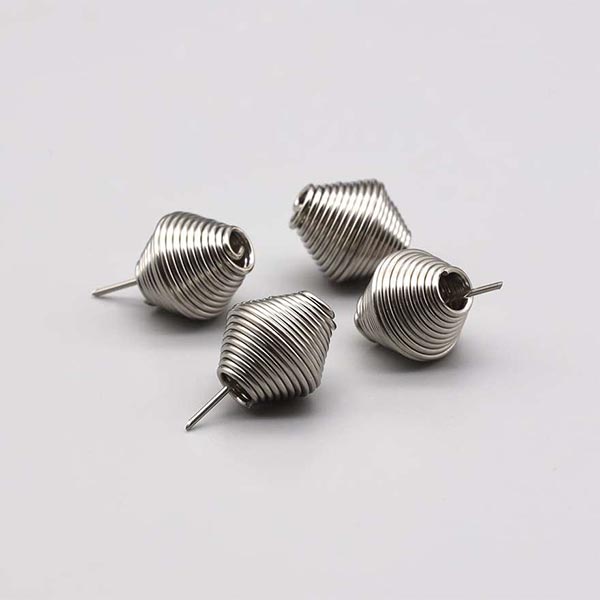
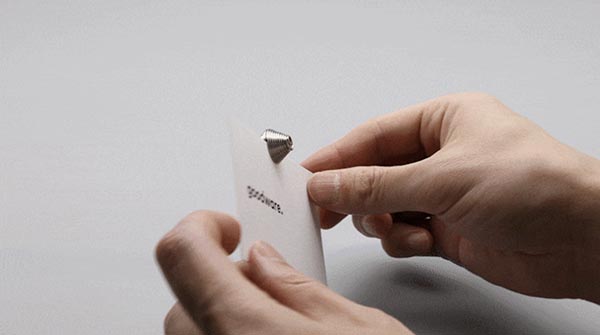

Does Anyone Really Know What Time it Is?
The first mechanical clocks started appearing in Europe around the start of the 14th century, the start of an obsession with timepieces that has culminated perhaps in the atomic clock or perhaps the smart watch. Before the clock, people used various low-tech devices to tell time, the most popular perhaps being the sundial, which dates back to ancient Egypt. The ancient Greeks used a water clock called a clepsydra, a Rube Goldberg-esque device that used water rising at a known rate to hit a mechanical bird that then triggered a whistle. There is no time to completely list all the various ways people used to tell the time.
Interestingly, in 6th-century China, they began using fire and smoke to tell the time via “incense clocks,” which continued to be popular until quite recently. Jstor explains:
The incense clock takes the form of a maze of incense, with a tiny ember slowly burning through it. Early in the Qing dynasty (1644–1911), incense clocks burned all night in Beijing’s tall drum tower, measuring out the time until the beating of the huge drum announced the end of the night watch.
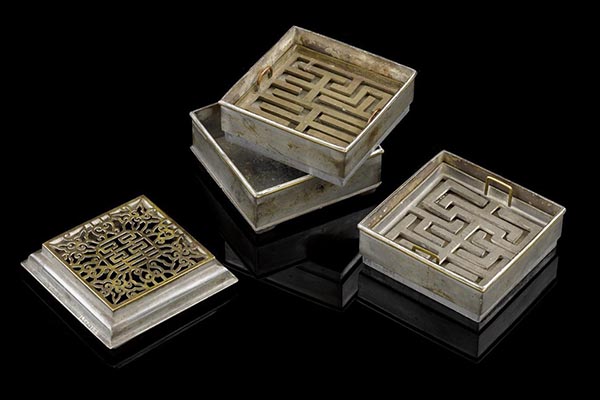
Caption from Jstor: Chinese incense clock that measures time by burning powdered incense along a pre-measured path, with each stencil representing a different amount of time (via JSTOR).
To set the clock, start by smoothing the ashes with the damper until they are perfectly flat. Select your stencil, then use the sharp edge of the shovel to carve out a groove, following the pattern, and fill it with incense. Finally, cap it with the lacy lid to vent the smoke and control the flow of oxygen.
To track smaller intervals of time, place small markers at regular points along the path. Some versions had little chimneys dispersed across the lid, allowing the hour to be read based on which hole the smoke was venting through. And some users may have used different kinds of incense at different parts of the path, or inserted scented chips along the way, so that they could tell the time with just a sniff.
When mechanical clocks were introduced, they were prohibitively expensive for all but the wealthy, while incense was fairly cheap. The use of incense cocks continued well into the 20th century.
Time Lord
Speaking of clocks, a man you have probably never heard of—but has long been a key figure in ensuring that the Internet works—is retiring. Via Boing Boing, David Mills is a computer engineer who began his career at COMSAT and ARPANET in the early days of the development of what would become the Internet.
Mills was one of the first people to realize that networked computers would need to be running on synchronized internal clocks — and has essentially spent the rest of his life as the Internet’s very own personal Father Time, making sure the computerized clocks around the globe are ticking at the right time.
The New Yorker takes up the story.
Mills called his creation the Network Time Protocol, and N.T.P. soon became a key component of the nascent Internet. Programmers followed its instructions when they wrote timekeeping code for their computers. By 1988, Mills had refined N.T.P. to the point where it could synchronize the clocks of connected computers that had been telling vastly differing times to within tens of milliseconds—a fraction of a blink of an eye. “I always thought that was sort of black magic,” Vint Cerf, a pioneer of Internet infrastructure, told me.
Today, we take global time synchronization for granted. It is critical to the Internet, and therefore to civilization. Vital systems—power grids, financial markets, telecommunications networks—rely on it to keep records and sort cause from effect. N.T.P. works in partnership with satellite systems, such as the Global Positioning System (G.P.S.), and other technologies to synchronize time on our many online devices.
Mills has been the only one maintaining this system for all these years. He’s now 84 years old and he’s apparently decided his, um, time is up, as he has announced his retirement. There’s no successor in place…who will be the next Time Lord?
Spit in the Ocean
Consider the wax worm (Galleria mellonella), a moth larva that eats the wax bees make to build honeycombs. They decidedly unloved by beekeepers, as it also eats pollen, honey, and even bee larvae, but scientists have discovered that wax worms could potentially be used to combat plastic pollution as their saliva has been found to degrade polyethylene. From NBC News:
The researchers said the two enzymes identified in the caterpillar saliva were found to rapidly and at room temperature degrade polyethylene, the world’s most widely used plastic and a major contributor to an environmental crisis extending from ocean trenches to mountaintops.
In order for plastic to degrade, oxygen must penetrate it, and the problem thus is that plastic was designed specifically to thwart penetration. That’s why plastic is so useful. However, wax worm saliva can readily penetrate those polymers and effect the degrading of plastic, potentially solving one of the great environmental problems of the age.
The idea would be to produce the worms’ saliva enzymes synthetically, which the researchers succeeded in doing, to break down plastic waste. Bertocchini said the use of billions of wax worms to do the job has drawbacks including generating carbon dioxide as they metabolize the polyethylene.
“In our case, the enzymes oxidize plastics, breaking it into small molecules. This suggests alternative scenarios to deal with plastic waste in which plastics can be degraded in controlled conditions, limiting or eventually eliminating altogether the release of microplastics,” said study co-author Clemente Fernandez Arias, an ecologist and mathematician at CSIC.
Other biological entities, such as microorganisms, have also been found to help break down plastic, but not as quickly as wax worm spit and requiring pre-treatment of the plastic, which makes that less than ideal as a solution. The wax worms show the most promise.
Corn Sole
Following in the foot[wear]steps of Allbirds and Nike, Reebok has announced that it is launching a line of sneakers made from natural materials—in this case, cotton and corn. Says CBS News:
The company announced its plans last spring to create a sneaker with an upper part made from organic cotton and a sole from corn…
It’s not the corn that ends up on your dinner plate. Rather, it’s the kind typically used to feed livestock. The corn is milled and fermented into a bio-based product that is eventually molded into a shoe sole.
… The cotton and corn shoes are now available online and are selling for $95 – in the same price range of the classic sneaker. Though the shoe is sustainable, it’s not yet biodegradable. Reebok is working on a second version of the shoe that will be compostable, so you’ll be able to bury it in your backyard.
And a third version you can eat, à la Charlie Chaplin in The Gold Rush.
Around the Webb, Part the Continuation: Angry Red Planet
The James Webb Space Telescope is up and running and recently turned its gaze toward Mars, which actually presented some challenges. The Webb was designed to catch extremely faint light from the far distant reaches of the universe and to look at something so close is, in a way, blinding, like when you go from a dark room into bright sunlight. In the case of the Webb, the “blinding” phenomenon known as “detector saturation.” So astronomers shortened the exposure time.
Says NASA:
Webb’s unique observation post nearly a million miles away at the Sun-Earth Lagrange point 2 (L2) provides a view of Mars’ observable disk (the portion of the sunlit side that is facing the telescope). As a result, Webb can capture images and spectra with the spectral resolution needed to study short-term phenomena like dust storms, weather patterns, seasonal changes, and, in a single observation, processes that occur at different times (daytime, sunset, and nighttime) of a Martian day.
Hopefully there is no malware in this image:
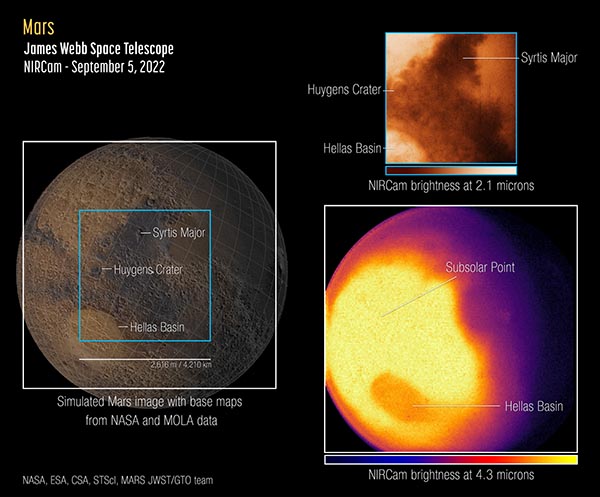
Credit: NASA, ESA, CSA, STScI, Mars JWST/GTO team
The NIRCam shorter-wavelength (2.1 microns) image [top right] is dominated by reflected sunlight, and thus reveals surface details similar to those apparent in visible-light images [left]. The rings of the Huygens Crater, the dark volcanic rock of Syrtis Major, and brightening in the Hellas Basin are all apparent in this image.
The NIRCam longer-wavelength (4.3 microns) image [lower right] shows thermal emission – light given off by the planet as it loses heat. The brightness of 4.3-micron light is related to the temperature of the surface and the atmosphere. The brightest region on the planet is where the Sun is nearly overhead, because it is generally warmest. The brightness decreases toward the polar regions, which receive less sunlight, and less light is emitted from the cooler northern hemisphere, which is experiencing winter at this time of year.
However, temperature is not the only factor affecting the amount of 4.3-micron light reaching Webb with this filter. As light emitted by the planet passes through Mars’ atmosphere, some gets absorbed by carbon dioxide (CO2) molecules. The Hellas Basin – which is the largest well-preserved impact structure on Mars, spanning more than 1,200 miles (2,000 kilometers) – appears darker than the surroundings because of this effect.
“This is actually not a thermal effect at Hellas,” explained the principal investigator, Geronimo Villanueva of NASA’s Goddard Space Flight Center, who designed these Webb observations. “The Hellas Basin is a lower altitude, and thus experiences higher air pressure. That higher pressure leads to a suppression of the thermal emission at this particular wavelength range [4.1-4.4 microns] due to an effect called pressure broadening. It will be very interesting to tease apart these competing effects in these data.”
The things we can do.
Meanwhile, Back at the Ranch…
Do you like ranch dressing? Home décor? Well, why not combine them! No, not slather salad dressing all over your furniture (but to each his or her own), but purchase Hidden Valley’s new “Home Collection.” Yes, that is wallpaper, blankets, pillows, even a couch, decorated with designs inspired by its ranch dressing. Says Food and Wine:
Hidden Valley has launched an entire line of ranch-inspired decor with the help of interior designer Dani Dazey.
…The resulting “first-ever” Hidden Valley Home collection debuts today in an ad spot where Dazey decks out the ultimate Hidden Valley Ranch and pizza-inspired room — big splashes of green, white, blue, and orange with the recognizable shapes of Hidden Valley bottles and pizza slices. Hidden Valley says that five of Dazey's items will be available for a limited time in the brand's online Ranch Shop: the wallpaper, blanket, pillows, posters and — biggest of all — the $10,000 couch.
How did pizza get involved?

Courtesy of Hidden Valley Ranch
Good grief. It makes Peewee’s Playhouse look understated and dignified. We’ll keep that valley hidden, thanks.
From there, Hidden Valley has fleshed out the collection with even more items to accentuate your home — things like comforters, shams, bathmats, shower curtains, placemats, coasters, tablecloths, notebooks, bags, and pouches — all of which pop with signature colors and curves of the brand's dressing bottles.
We can’t wait to see what Ken’s Steakhouse is up to.
This Week in Printing, Publishing, and Media History
October 3
1896: English author and poet William Morris dies (b. 1834).
1949: WERD, the first black-owned radio station in the United States, opens in Atlanta.
1954: American guitarist and singer-songwriter Stevie Ray Vaughan born.
1957: The California State Superior Court rules that Allen Ginsberg’s Howl and Other Poems is not obscene.
1987: French playwright and screenwriter Jean Anouilh dies (b. 1910).
2005: English actor and screenwriter Ronnie Barker dies (b. 1929).
October 4
1535: The Coverdale Bible is printed, with translations into English by William Tyndale and Myles Coverdale.
1582: The Gregorian Calendar is introduced by Pope Gregory XIII.
1669: Dutch painter and illustrator Rembrandt van Rijn dies (b. 1606).
1880: American newspaperman and short story writer Damon Runyon born.
1883: First run of the Orient Express. (No murder on it…yet.)
1927: Gutzon Borglum begins sculpting Mount Rushmore.
1941: Norman Rockwell’s Willie Gillis character debuts on the cover of The Saturday Evening Post.

1957: Sputnik 1 becomes the first artificial satellite to orbit the Earth.
1985: The Free Software Foundation is founded.
1989: English actor and screenwriter Graham Chapman dies (b. 1941).
October 5
1947: In the first televised Oval Office address, President Truman asks Americans to reduce their consumption of grain in order to help starving Europeans.
1949: English biographer, novelist and critic Peter Ackroyd born.
1970: The Public Broadcasting Service (PBS) is founded.
2011: American businessman, co-founder of Apple Inc. and Pixar Steve Jobs dies (b. 1955).
October 6
1723: Benjamin Franklin arrives in Philadelphia at the age of 17.
1927: Opening of The Jazz Singer, the first significant “talkie” movie.
2010: Instagram is founded by Kevin Systrom and Mike Krieger.
2020: Dutch-American guitarist, songwriter, and producer Eddie Van Halen dies (b. 1955).
October 7
1777: The Americans defeat the British in the Second Battle of Saratoga, also known as the Battle of Bemis Heights.
1849: American short story writer, poet, and critic Edgar Allan Poe dies (b. 1809).
1885: Danish physicist and philosopher and Nobel Prize laureate Niels Bohr born.
1919: KLM, the flag carrier of the Netherlands, is founded. It is the oldest airline still operating under its original name.
1959: The Soviet probe Luna 3 transmits the first-ever photographs of the far side of the Moon.
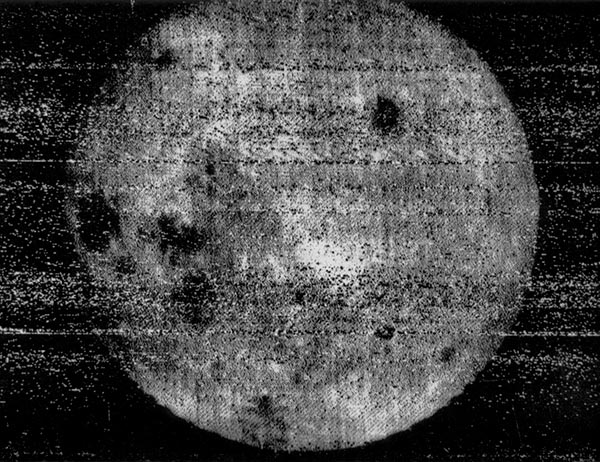
October 8
1921: KDKA in Pittsburgh's Forbes Field conducts the first live broadcast of a football game.
1962: Der Spiegel publishes an article disclosing the sorry state of the Bundeswehr, and is soon accused of treason.
1982: Cats opens on Broadway and runs for nearly 18 years before closing on September 10, 2000.
October 9
1446: The hangul alphabet is published in Korea.
1874: The Universal Postal Union is created by the Treaty of Bern.
1907: French actor, director, and screenwriter Jacques Tati born.
1940: John Lennon born.
1986: The Phantom of the Opera, eventually the second longest running musical in London, opens at Her Majesty’s Theatre.
1987: American author, playwright, and diplomat, United States Ambassador to Italy Clare Boothe Luce dies (b. 1903).
2004: Algerian-French philosopher and academic Jacques Derrida dies (b. 1930).










Discussion
Join the discussion Sign In or Become a Member, doing so is simple and free